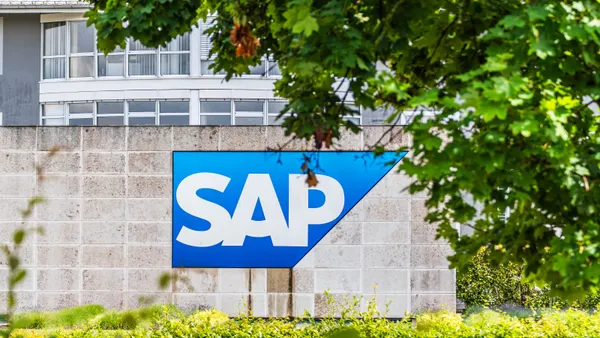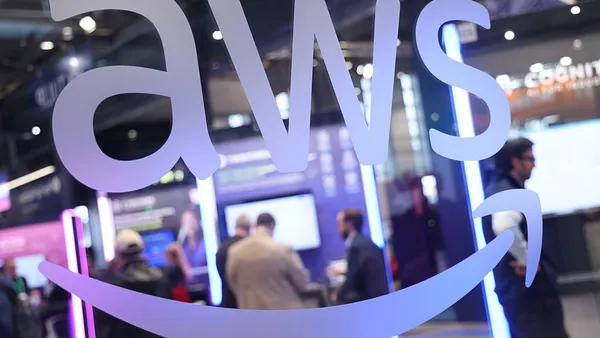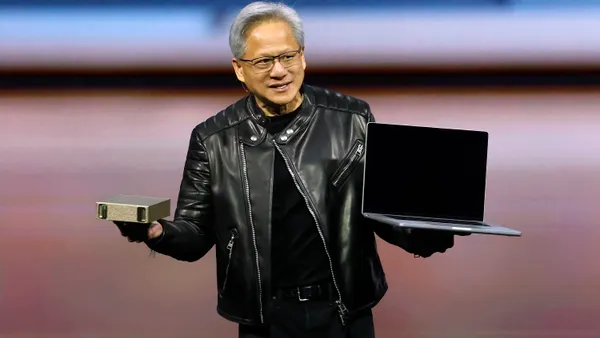Dive Brief:
- Nvidia CEO Jensen Huang touted the potential of open-source AI models as the GPU giant moves to capture the enterprise market for high-capacity compute, speaking Wednesday during the company’s Q2 2026 earnings call for the three months ending July 27.
- “Open-source models are opening up large enterprise, SaaS companies, industrial companies, robotics companies to now join the AI revolution,” said Huang. “It's really fueled the adoption of AI in enterprises around the world because enterprises want to build their own custom proprietary software stacks,” he added.
- Nvidia targeted enterprise AI workloads with the GPU-powered RTX Pro server, released earlier this month and adopted by Disney, Hyundai, Lilly, SAP and several other large companies. The hardware is designed for “standard IT environments and [to] run traditional enterprise IT applications, as well as the most advanced agentic and physical AI applications,” Nvidia EVP and CFO Colette Kress said. “As enterprises modernize data centers, RTX PRO servers are poised to become a multibillion-dollar product line.”
Dive Insight:
The AI gold rush transformed Nvidia’s niche gaming chips business into a massive cloud-building operation, driving triple-digit, year-over-year revenue growth for five consecutive quarters through July 2024. A shift to large language model infrastructure led by hyperscale cloud providers increased Nvidia's quarterly revenues nearly seven-fold in three years.
The company reported $46.7 billion in revenue for the most recent quarter, as year-over-year growth slowed to a robust 56%, down from 69% the prior quarter and 122% in Q2 2025. Nvidia expects a similar trajectory to hold in Q3, according to Kress, who projected revenue growth in the mid-fifty-percent range to roughly $54 billion.
Nvidia revenues grew nearly eightfold in three years
Nvidia’s expansion has been fueled largely by ongoing hyperscaler capital investments in AI infrastructure. Last month, Google Cloud increased its ante by $10 billion to $85 billion for the year. Microsoft expects to spend $30 billion in the next quarter to satisfy growing demand for cloud and AI services, and AWS — the largest of the three big hyperscalers — has pledged to spend $100 billion this year on capital investments.
As the building boom spread from big tech to enterprise, Nvidia mobilized its network of hardware manufacturing partners to begin shipping its GPU-powered DGX Spark PCs and DGX Station desktop units last month.
Servers have already seen a sales spike, according to IDC data. During the first three months of the year, GPU demand triggered the server market’s largest quarterly increase in 25 years, with sales skyrocketing 134% to $95.2 billion, the firm found.
Analysts nevertheless expect a general slowdown in GPU sales growth, even as the enterprise market picks up, largely due to the lower volume of compute needed to run smaller models. The market for AI infrastructure, which shot up 250% from 2022 to 2024, will slow to 67% year-over-year growth in 2025, according to an Omdia market analysis published Thursday.
“The shift towards smaller, specialized models is slowing demand for AI computing, as are generation-on-generation improvements in AI model efficiency,” Alexander Harrowell, Omdia principal analyst for advanced computing, said in the report. “These improvements include better curation of training datasets, advances in fundamental model design, and operational optimizations in inference.”
Nvidia is betting on a diversified suite of hardware and software products to sustain its growth.
“We’re famous for building the GPU and investing the GPU but, as you know, over the last decade we’ve really transitioned to become an AI infrastructure company,” Huang said.
As AI use cases proliferate, the company expects hyperscaler and enterprise infrastructure needs to keep pace.
“We are at the beginning of an industrial revolution that will transform every industry,” Kress said. The company expects infrastructure spend to reach $3 trillion to $4 trillion in the next 10 years.
Disclosure: Informa, which owns a controlling stake in Informa TechTarget, the publisher behind CIO Dive, is also invested in Omdia. Informa has no influence over CIO Dive’s coverage.














